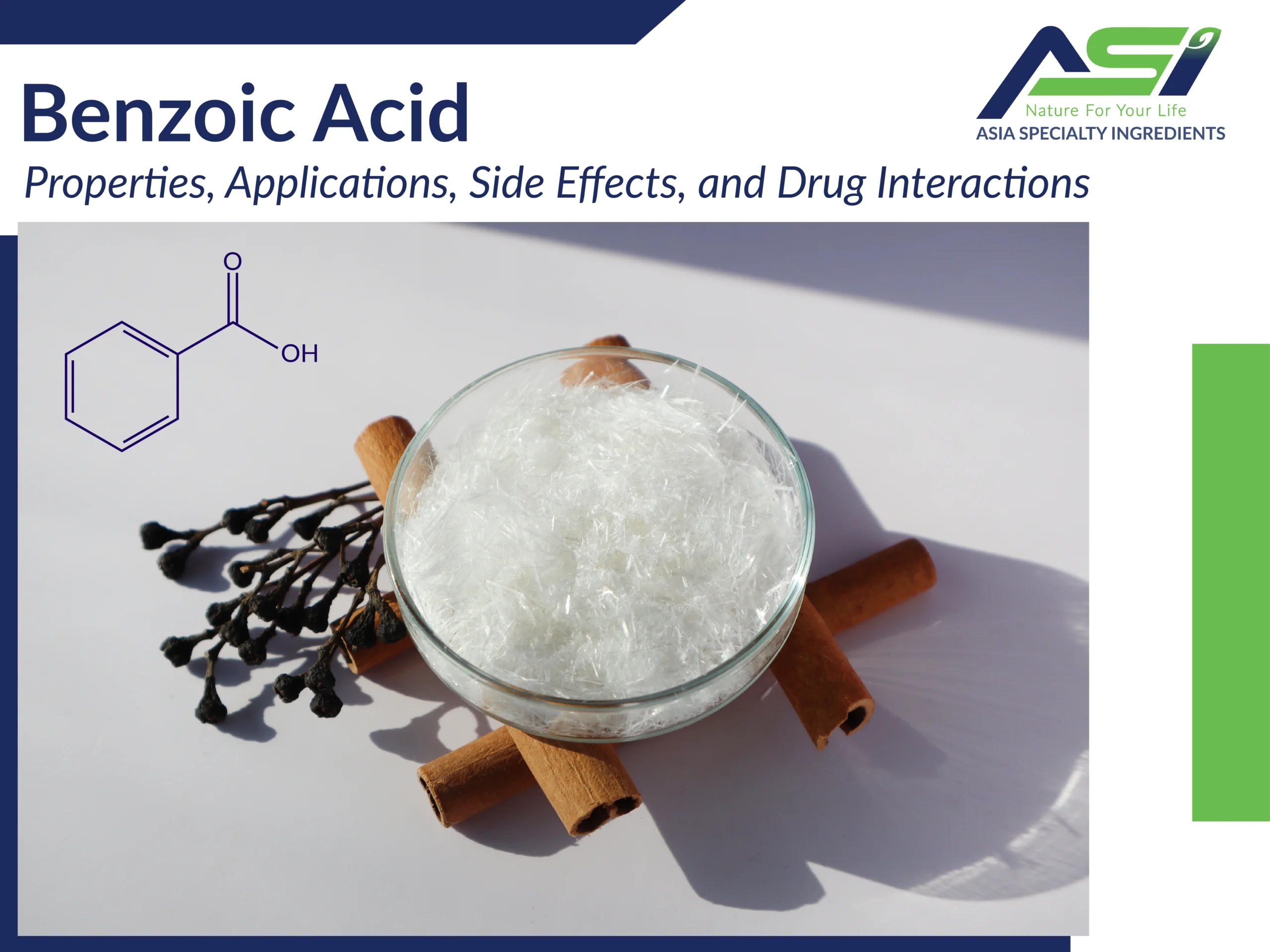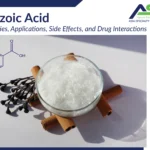Benzoic acid
Chemical Formula: C7H602
Exact Mass: 122.04
Molecular Weight: 122.12
m/z: 122.04 (100.0%), 123.04 (7.7%)
Elemental Analysis: C, 68.85; H, 4.95; 0, 26.20
Table of Content
ToggleWhat is Benzoic Acid?
Benzoic acid is a white solide or colorless needle-shaped crystals with the formula C6H5COOH. It has a faint and pleasant odor. Due to its versatile properties, benzoic acid finds applications in various industries, including food preservation, pharmaceuticals, and cosmetics.
Key Physical Properties of Benzoic Acid:
• At 15℃, benzoic acid has a density of 1.266 g/cm³.
• Its melting point is 122℃ and boiling point is 250℃.
• High solubility in hot water, low solubility in cold water.
• Easily dissolves in organic solvents such as acetone, alcohol, benzene, liquid ammonia, ether, and chloroform.
• Benzoic acid has an acid dissociation constant (pKa) of 4.2 in water.
Benzoic acid in nature
Benzoic acid and its esters are naturally present in various plant and animal species. Notably, many berries have significant concentrations, approximately 0.05%. The ripe fruits of several Vaccinium species, such as cranberry (V. vitis-idaea) and bilberry (V. myrtillus), can contain free benzoic acid levels ranging from 0.03% to 0.13%. Additionally, apples generate benzoic acid when infected by the fungus Nectria galligena. This compound has also been detected in the internal organs and muscles of the rock ptarmigan (Lagopus muta), as well as in the glandular secretions of male muskoxen (Ovibos moschatus) and Asian bull elephants (Elephas maximus). Furthermore, gum benzoin can contain up to 20% benzoic acid and 40% of its esters.
Benzoic acid, sourced from cassia oil, is perfect for cosmetics that are entirely plant-based.
Application of Benzoic Acid
1. The production of phenol involves the utilization of benzoic acid. It is established that phenol can be derived from benzoic acid through the process of treating molten benzoic acid with an oxidizing gas, ideally air, along with steam at temperatures ranging from 200°C to 250°C. 2. Benzoic acid serves as a precursor to benzoyl chloride, which plays a significant role in the manufacturing of a wide range of chemicals, dyes, fragrances, herbicides, and pharmaceuticals. Additionally, benzoic acid undergoes metabolism to form benzoate esters, benzoate amides, thioesters of benzoates, and benzoic anhydride. It is an essential structural element in many vital compounds found in nature and is crucial in organic chemical.
2. Benzoic acid serves as a precursor to benzoyl chloride, which plays a significant role in the manufacturing of a wide range of chemicals, dyes, fragrances, herbicides, and pharmaceuticals. Additionally, benzoic acid undergoes metabolism to form benzoate esters, benzoate amides, thioesters of benzoates, and benzoic anhydride. It is an essential structural element in many vital compounds found in nature and is crucial in organic chemical. 3. One of the main applications of benzoic acid is as a preservative within the food sector. It is frequently utilized in beverages, fruit products, and sauces, where it plays a crucial role in preventing the growth of molds, yeasts, and certain bacteria.
3. One of the main applications of benzoic acid is as a preservative within the food sector. It is frequently utilized in beverages, fruit products, and sauces, where it plays a crucial role in preventing the growth of molds, yeasts, and certain bacteria.
4. In the realm of pharmaceuticals, benzoic acid is often combined with salicylic acid to address fungal skin conditions such as athlete’s foot, ringworm, and jock itch. Additionally, it is used in topical formulations due to its keratolytic effects, which assist in the removal of warts, corns, and calluses. When used for medicinal purposes, benzoic acid is generally applied topically. It is available in various forms, including creams, ointments, and powders. The concentration of benzoic acid in these products typically ranges from 5% to 10%, often paired with a similar concentration of salicylic acid. For effective treatment of fungal skin infections, it is essential to clean and dry the affected area thoroughly before applying a thin layer of the medication. The application is usually recommended two to three times a day, and adhering to the guidance of a healthcare professional is vital for achieving the best results.
What are Benzoic Acid Side Effects?
Benzoic acid is typically regarded as safe when used correctly; however, it may lead to side effects in certain individuals. The most frequently reported side effects include localized skin reactions such as redness, itching, and irritation. These symptoms are generally mild and temporary, though they can be uncomfortable for some. If irritation continues or intensifies, it is advisable to stop using the product and seek guidance from a healthcare professional.
Those with a known hypersensitivity to benzoic acid or any of its ingredients should refrain from using products that contain this compound. Additionally, it is contraindicated for use on open wounds or broken skin, as the acid’s absorption through compromised skin may result in systemic toxicity. Symptoms of systemic toxicity may include nausea, vomiting, abdominal discomfort, and dizziness, necessitating immediate medical intervention.
Pregnant and breastfeeding women are encouraged to consult their healthcare provider prior to using products containing benzoic acid to ensure safety for themselves and their infants. Although evidence regarding the effects of benzoic acid during pregnancy and lactation is limited, it is always wise to prioritize caution.
What Other Drugs Will Affect Benzoic Acid?
Benzoic acid can interact with various medications and substances, which may influence its effectiveness or heighten the likelihood of side effects. A significant interaction occurs with drugs that impact liver function, as the liver is vital for the metabolism of benzoic acid. For example, valproic acid, commonly prescribed for epilepsy and bipolar disorder, can affect the metabolism of benzoic acid, potentially resulting in elevated levels in the body and an increased risk of toxicity.
Furthermore, when using benzoic acid alongside other topical treatments, careful monitoring is necessary. The combination of benzoic acid with other keratolytic agents or potent acids may heighten the risk of skin irritation and damage. It is crucial to disclose all medications and topical treatments to healthcare providers to prevent adverse interactions.
Additionally, alcohol consumption can influence the safety and effectiveness of benzoic acid. Alcohol may alter skin permeability and enhance the absorption of topical medications, which could lead to systemic effects. Therefore, it is recommended to limit or avoid alcohol intake during treatment with products containing benzoic acid.
Conclusion
In summary, benzoic acid is a valuable compound with a wide range of applications. Its natural occurrence, preservative properties, and versatility make it a valuable component in various industries. However, it is essential to use benzoic acid safely and responsibly, following the recommended guidelines and consulting with a healthcare professional when necessary.
Asia Specialty Ingredients (ASI), part of Asia Ingredients Group (AIG), specializes in the production and global export of essential oils and natural aromatics. Our range of products is meticulously processed using only the finest natural ingredients sourced from the typical lands of Vietnam, including Natural Benzaldehyde, Natural Benzoic Acid, Natural Cinnamic Aldehyde and more, ensuring good product quality. Contact us for more collaboration opportunity!








